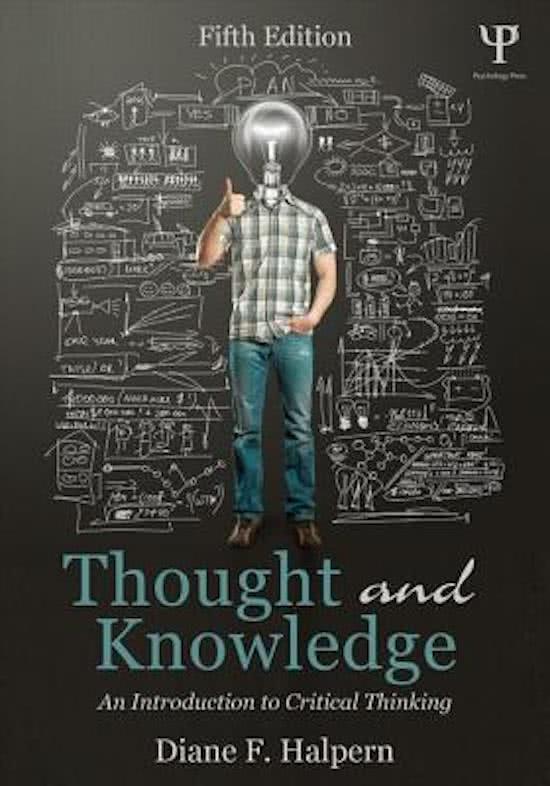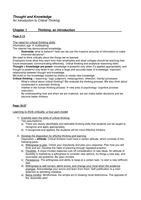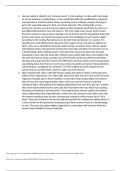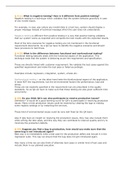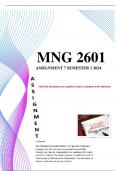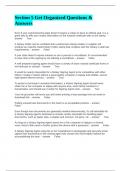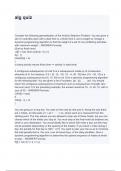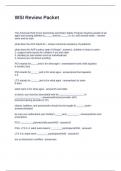Thought and Knowledge
An Introduction to Critical Thinking
Chapter 1 Thinking: an introduction
Page 2-13
The need for critical thinking skills
Information age multitasking.
The internet has democratized knowledge.
- Downside: what to believe? How can we use the massive amounts of information to make
informed decisions?
We need to think critically about the things we’ve learned.
Employers know what they want from their employees and what colleges should be teaching their
future employees: communicating effectively, ‘critical thinking and analytical reasoning skills’.
Thought + knowledge are power: knowledge is powerful only when it’s applied appropriately, and
thought is powerful only when it can utilize a large and accurate base of knowledge: important
relationship between thought and knowledge.
We build on the knowledge created by others to create new knowledge.
Critical thinking = reasoning / logic judgment, metacognition, reflection, mental processes.
- What’s critical about critical thinking? We evaluate the thinking process. We also think about
nondirected or automatic thinking.
- Interest in the human thinking process new area of psychology: cognitive process
instruction.
- By understanding how and when we are irrational, we can make better decisions and we
become better thinkers.
Page 18-27
Learning to think critically: a four-part model
1) Explicitly learn the skills of critical thinking.
Two assumptions:
a) There are clearly identifiable and definable thinking skills that students can be taught to
recognize and apply appropriately.
b) If recognized and applied, the students will be more effective thinkers.
2) Develop the disposition for effortful thinking and learning
Disposition = attitude. Critical thinkers must have a certain attitude, which consists of the
following parts:
a) Willingness to plan. Check your impulsivity and plan your response. Plan how you will
think and act. Develop the habit of planning through repeated practice.
b) Flexibility. A close-minded response cuts off consideration of new ideas. An attitude of
flexibility is marked by a willingness to consider new options, try things a new way, and
reconsider old problems. Be open-minded.
c) Persistence. The willingness and ability to keep at a certain task / to start a new (difficult)
task.
d) Willingness to self-correct, admit errors, and change your mind when the evidence
changes. Acknowledge your errors and learn from them. Self-justification is a main
deterrent to admitting mistakes.
e) Being mindful. Mindfulness: the simple act of drawing novel distinctions. The opposite of
the ‘automatic pilot’.
An Introduction to Critical Thinking
Chapter 1 Thinking: an introduction
Page 2-13
The need for critical thinking skills
Information age multitasking.
The internet has democratized knowledge.
- Downside: what to believe? How can we use the massive amounts of information to make
informed decisions?
We need to think critically about the things we’ve learned.
Employers know what they want from their employees and what colleges should be teaching their
future employees: communicating effectively, ‘critical thinking and analytical reasoning skills’.
Thought + knowledge are power: knowledge is powerful only when it’s applied appropriately, and
thought is powerful only when it can utilize a large and accurate base of knowledge: important
relationship between thought and knowledge.
We build on the knowledge created by others to create new knowledge.
Critical thinking = reasoning / logic judgment, metacognition, reflection, mental processes.
- What’s critical about critical thinking? We evaluate the thinking process. We also think about
nondirected or automatic thinking.
- Interest in the human thinking process new area of psychology: cognitive process
instruction.
- By understanding how and when we are irrational, we can make better decisions and we
become better thinkers.
Page 18-27
Learning to think critically: a four-part model
1) Explicitly learn the skills of critical thinking.
Two assumptions:
a) There are clearly identifiable and definable thinking skills that students can be taught to
recognize and apply appropriately.
b) If recognized and applied, the students will be more effective thinkers.
2) Develop the disposition for effortful thinking and learning
Disposition = attitude. Critical thinkers must have a certain attitude, which consists of the
following parts:
a) Willingness to plan. Check your impulsivity and plan your response. Plan how you will
think and act. Develop the habit of planning through repeated practice.
b) Flexibility. A close-minded response cuts off consideration of new ideas. An attitude of
flexibility is marked by a willingness to consider new options, try things a new way, and
reconsider old problems. Be open-minded.
c) Persistence. The willingness and ability to keep at a certain task / to start a new (difficult)
task.
d) Willingness to self-correct, admit errors, and change your mind when the evidence
changes. Acknowledge your errors and learn from them. Self-justification is a main
deterrent to admitting mistakes.
e) Being mindful. Mindfulness: the simple act of drawing novel distinctions. The opposite of
the ‘automatic pilot’.

